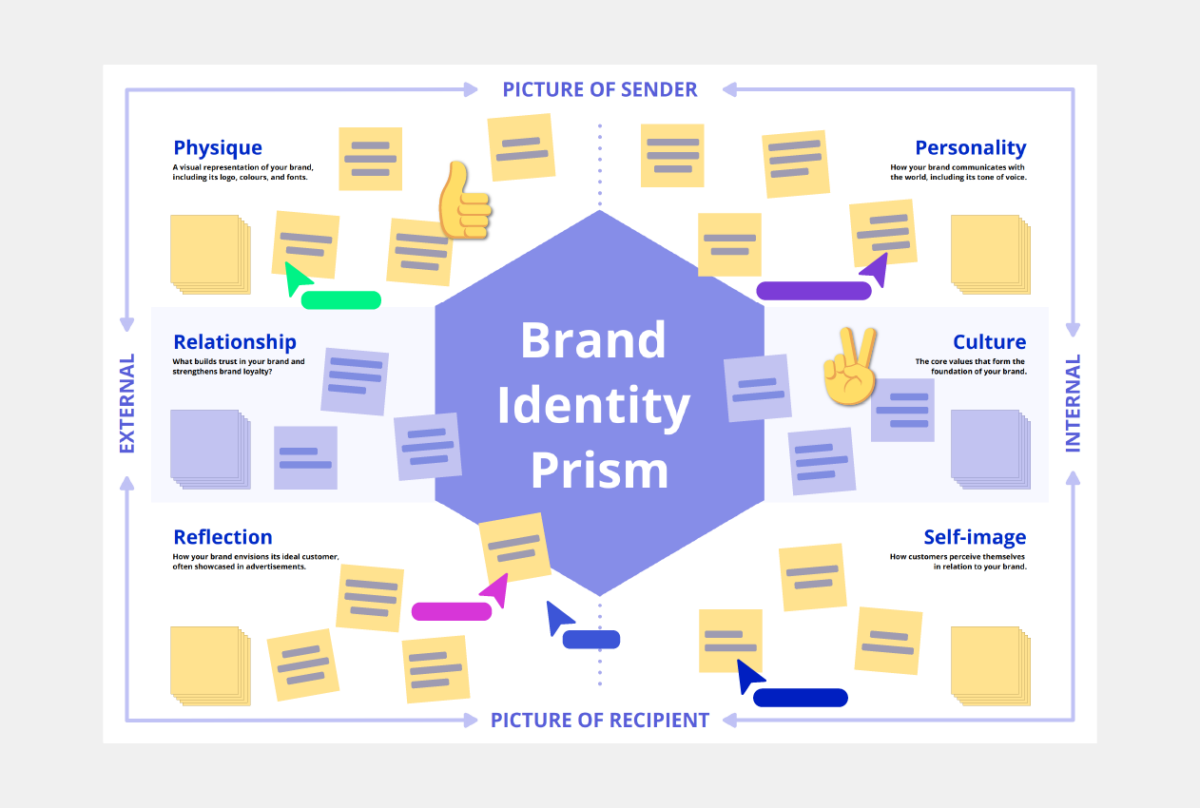Brand Identity Prism Template: Craft Your Brand Identity
The Kapferer’s brand identity prism is a helpful framework that outlines the various elements that go into building a brand identity. In this article, we unpack all the aspects of the model with the help of a brand identity prism template you can use and edit for free today!

As brand manager, one of your primary responsibilities is to help craft a unique brand identity. The brand identity is the core around which all the aspects of the brand revolve. From the value proposition to messaging and communication, everything is underpinned by how the brand sees itself and how it wants to be perceived by the outside world.
The Kapferer’s brand identity prism is a helpful framework that outlines the various elements that go into building a brand identity. In this article, we unpack all the aspects of the model with the help of a brand identity prism template you can use and edit for free today!
Brand Identity Prism- Overview
Created in 1996 by Professor Jean-Noël Kapferer, the framework was conceptualized to bring together the tangible and intangible elements of brand identity. He broke these down into 2 categories, viz, externalization and internalization. The internal component deals with how the brand sees itself, its values, its physical manifestation etc.
The external aspects are approached from the perspective of the consumer. This perspective has assumed outsize importance, given how marketing today must be more a conversation than a monologue.
Click on the below template to create your own brand identity prism or read on for a deeper dive into the various sections of the framework.

Sections of the brand identity prism
The brand identity prism is divided into 6 key sections, each of which represents an important facet of the brand. These are:
Physique
This section is all about the physical aspects of the brand. This goes above and beyond just the logo and the brand colours. How visually distinct and easy identifiable is your brand? What makes you stand out from the competition?
When the Coca-Cola designed its iconic bottle back in 1915, the brief to the designer was that the bottle should be recognizable in the dark or even if broken. This gave rise to the idea that brands need to be ‘smashable’, i.e, recognizable by its smallest elements. Be it a certain font, a smell or even a catchy jingle, this section encapsulates all the tangible aspects of a brand.
Personality
If your brand were a human being, how would you describe its character traits? Would you say it is optimistic? Fun-loving? Hopeful? Every aspect of the brand’s communication imbues it with a certain personality. From the choice of brand colours to the tone of communication, consumers form mental associations of a brand on the basis of these choices.
A use of red in a logo might signify excitement, romance, joy, or comfort, like in the case of brands like Coca-Cola, KFC, Levi’s, Canon, Lays, and Kit Kat. This section helps you understand desired mental associations and how to reinforce these in the minds of the consumers.
Culture
Culture is the bedrock on which your brand is built. All your values, beliefs and ideals are woven into your brand’s culture. At a very basic level, this section outlines what your brand stands for and why you do what you do.
Apple’s culture is that of innovation in the pursuit of achieving design excellence. Audi’s culture is rooted in progress through technological advancement. For a brand like Allbirds, the pervasive culture is that of making better things in a better, more sustainable way. What are the values your brand espouses?
Self-image
Brands change people. By associating with certain brands, people begin to see themselves in a different light. Apple users see themselves as nonconformists. Drinkers of Redbull consider themselves thrill seekers. It is important for brands to understand how their users view themselves.
What are the aspirations of your ideal customer? How can your brand help them achieve these? Like the use of a customer empathy map, this section helps you gain a deeper understanding of your core customer.
Reflection
While self-image is about how customer’s view themselves, reflection is about how the brand depicts its ideal customer. While sometimes there can be a large overlap between these two groups, these can also vary. For example, a brand like Harley-Davidson uses young, adventurous individuals in all its ads but in reality its core consumer might be much older, stuck in a 9-to-5 job who wants to feel young and carefree! An aspirational reflection of the ideal customer is in many ways the key to brand success!
Relationship
This is the role your brand sees itself playing in the consumer’s life. These could be that of a friend, a caregiver, a guide, or even a lover! Choosing a role and staying true to it helps maintain consistency of positioning and messaging. A brand like Dove sees itself playing the role of a caregiver, and all its messaging is similarly aligned. Pepsi wants to be considered the youth’s favourite drink and talks to its customers as a peer or a friend. Choose your role and establish a relationship that withstands the test of time!
Like the helpful framework outlined above, visual frameworks such as the BCG Matrix help you map-out your ideas and achieve alignment with your team. Conceptboard offers a variety of these templates for you to collaborate visually, manage projects and drive your team towards a unified purpose. Try it for free today!

